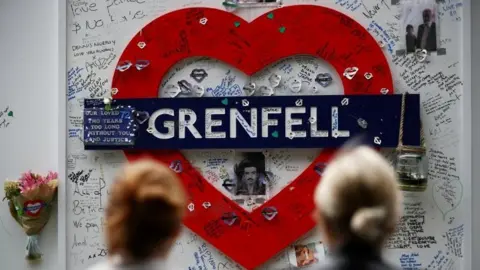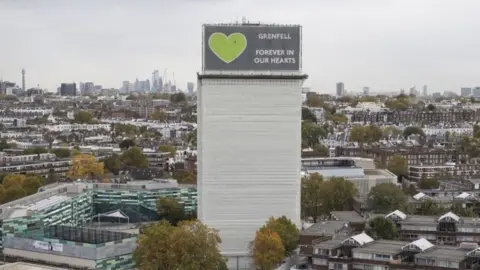Grenfell Tower fire: Firms 'knew cladding would fail in fire'
 Reuters
ReutersCompanies involved in the refurbishment of Grenfell Tower knew a planned cladding system would fail in the event of a fire, emails suggest.
The evidence was presented to the public inquiry into the fire at the London high-rise block.
The 2017 disaster killed 72 people.
The inquiry's second phase, which began on Monday, is looking at how the building came to be covered in flammable cladding during its refurbishment between 2012 and 2016.
The emails were disclosed to the inquiry by Celotex, which manufactured the insulation panels used in the work, as it defended suggestions it had not made clear the product would burn.
In an internal email sent in March 2015, Daniel Anketell-Jones, a technical manager at the cladding design company Harley, said the aluminium composite material (ACM) cladding "will be gone rather quickly in a fire!"
In another email, Terry Ashton, from the fire consultants Exova, accepted the zinc cladding being considered at the time would fail if there were external flames.
In response, Neil Crawford, from the architect firm Studio E said that "metal cladding always burns and falls off".
'Clear and specific warnings'
The inquiry is hearing opening statements, but some companies have introduced previously unpublished evidence as they seek to blame other firms involved.
In what the inquiry has described as a "merry-go-round of buck-passing", the firms who carried out the refurbishment have said they were misled about the safety of the materials they chose.
The manufacturers have hit back that they should have carried out tests and satisfied themselves that what they were designing was safe.
Celotex made the RS5000 insulation which contributed to the fire. But the company told the inquiry it was always sold on the basis that it did burn.
The company said it had carried out tests and the thick insulation panels could be safely used with cladding which was not combustible, rather than with the type used at Grenfell, which was.
Its barrister, Craig Orr QC, said it was "abundantly clear that the cladding system designed and installed on Grenfell Tower bore no resemblance to the system as described in Celotex's marketing materials".
He said the architects, cladding firm, and fire safety advisers should all have been aware of "clear and specific warnings" about fire safety in the marketing materials for the insulation.
As the manufacturer, Mr Orr argued it was not Celotex's job to ensure the product was being used safely - and said this was a matter for the designers, contractors and consultants.
 Getty Images
Getty ImagesAnother company involved, cladding manufacturer Arconic Architectural Products, also said it was not required to ensure its product could be safely used on tall buildings.
Arconic said architects and designers were responsible for choosing materials and ensuring they did not provide a fire risk.
The company said building regulations did allow its combustible cladding to be used, as part of a wider system, as long as the system had undergone a successful fire test.
But no evidence suggested a test, or assessment of previous similar tests, had been carried out in the context of the Grenfell Tower refurbishment, the company's barrister said.
Test results not passed on
On Monday, the inquiry heard that Arconic had failed to pass the results of testing, which suggested its cladding was far less safe in a fire than it had admitted, to a British certification body, the BBA.
The company's barrister said it would respond to that later in the inquiry but he insisted the certificate for the Reynobond PE cladding panels said that the way it was used could affect the way it reacted in a fire.
Earlier, Exova, the fire safety consultancy which reviewed the refurbishment, said criticism of it was "unjustified" because it was not consulted about the combustible materials which were eventually installed on the exterior of the block.
The company said it had only been asked to comment on early plans for the tower's refurbishment and was "left out" of later discussions surrounding cladding.
Both the Reynobond PE cladding panels and the Celotex RS5000 insulation were combustible and during the inquiry's first phase were found to be a key factor in the fire's rapid spread on 14 June, 2017.
